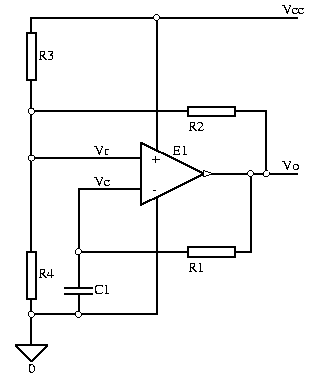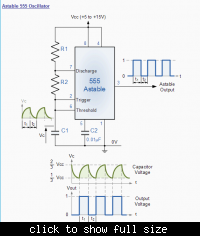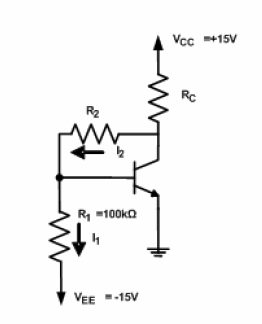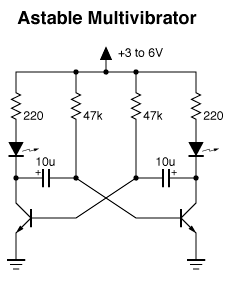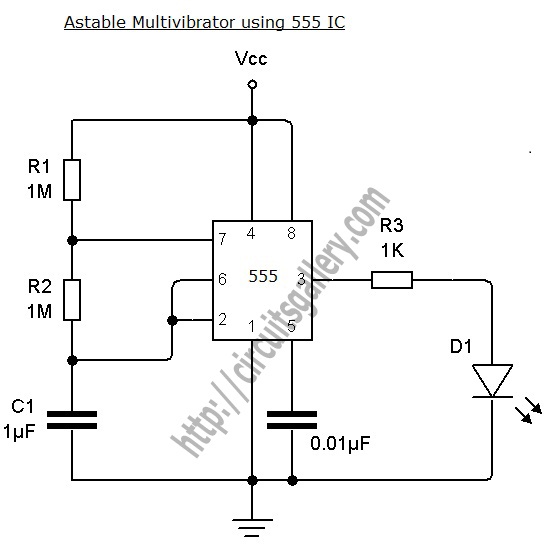
BJT Astable Multivibrators
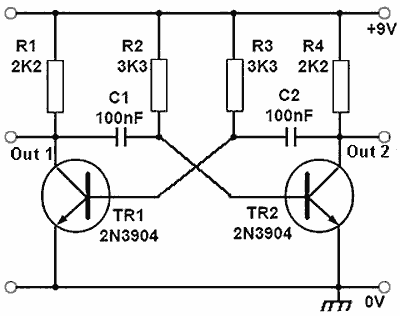
The basic bipolar transistor (BJT) version of an astable multivibrator has two outputs that repeatedly change state at a rate determined by the time constants of its feedback network. Although largely superseded by its equivalent op-amp or timer IC versions in many applications, it remains a useful and flexible design for square wave and pulse generation. The circuit continuously switches from one state (TR1 on and TR2 off) to the other (TR1 off and TR2 on) and back again at a rate determined by the RC timing components C1/R2 and C2/R3. The circuit produces two anti-phase square wave signals, with an amplitude almost equal to its supply voltage, at its two transistor collectors. When the circuit is powered on, TR1 conducts heavily while TR2 is turned off. The collector of TR1 will be nearly at zero volts, and the left plate of C1 will also be at zero volts. Since TR2 is off, its collector will be at supply voltage, and its base will be at almost zero potential, the same as the TR1 collector, because C1 remains uncharged. C1 starts to charge through R2, and its right plate becomes increasingly positive until it reaches about +0.6V. This voltage, connected to the base of TR2, causes TR2 to conduct heavily. The increasing collector current through TR2 creates a voltage drop across R4, causing the collector voltage of TR2 to fall, which in turn causes the right plate of C2 to drop rapidly in potential. Due to the nature of capacitors, as the right plate of C2 falls from supply voltage to almost zero, the left plate must also fall by a similar amount. With TR1 conducting, its base voltage drops to approximately 0.6V, leading to a negative voltage at the base of TR1, which turns it off rapidly. This sudden change at the collector of TR1 is transmitted through C1 to the base of TR2, causing TR2 to turn on as TR1 turns off. This change of state occurs at both outputs. However, this state does not last, as C2 begins to charge through R3. Once the voltage at the left plate (base of TR1) reaches about +0.6V, another rapid change of state occurs. The circuit continues to change states in this manner, producing a square wave at each collector. The frequency of oscillation can be calculated based on the time for the relevant capacitor to charge sufficiently for a state change, which is approximately 0.7CR. Since two changes of state occur in each cycle, the periodic time T can be determined. A limitation of the basic astable circuit is that the capacitor action slows down the voltage rise as each transistor turns off, resulting in curved rising edges of the square wave. This issue can be addressed with a modified circuit, where D2 becomes reverse biased when TR2 collector voltage goes high, isolating TR2 from the effects of C2 charging. The charging current for C2 is now supplied by R5 instead of R6. The output waveforms at the collectors of TR1 and TR2 demonstrate improved rise times achieved by the modified circuit compared to the basic BJT astable circuit. By varying VR1, the voltage at the top of both R3 and R4 can be adjusted to control the mark-to-space ratio.
The bipolar junction transistor (BJT) astable multivibrator circuit operates as a fundamental oscillator, producing two complementary square wave outputs. The configuration consists of two NPN transistors (TR1 and TR2), resistors (R2, R3, R4, R5, and R6), and capacitors (C1 and C2) forming a feedback network that dictates the timing characteristics of the oscillation.
Upon powering the circuit, TR1 is initially in a conductive state, causing TR2 to remain off. The charging of capacitor C1 through resistor R2 establishes the initial conditions for oscillation. As C1 charges to approximately 0.6V, TR2 turns on, which causes a cascade effect that turns off TR1. This rapid switching action is responsible for generating the square wave outputs at the collectors of both transistors.
The timing of the oscillation is influenced by the values of the resistors and capacitors in the circuit. The time constants, determined by the products of resistance and capacitance (RC), govern the charging and discharging cycles of the capacitors, thus controlling the frequency of oscillation. The frequency can be expressed mathematically, allowing for precise design adjustments to achieve desired output characteristics.
In the modified version of the circuit, the introduction of diode D2 enhances performance by preventing the feedback capacitor C2 from affecting the operation of TR2 during its off state. This modification significantly improves the rise and fall times of the output waveforms, resulting in a more defined square wave signal. The ability to adjust the mark-to-space ratio through VR1 further adds to the versatility of the design, making it suitable for various applications in signal generation and timing circuits.
Overall, the BJT astable multivibrator remains a valuable circuit design, providing a cost-effective and efficient means of generating square waves and pulses in electronic applications.The basic bipolar transistor (BJT) version of an astable multivibrator as shown in Fig. 4. 1. 1 has two outputs that repeatedly change state at a rate determined by the time constants of its feedback network. Although largely superseded by its equivalent op amp or timer IC versions in many applications, it is still a useful and flexible design for s
quare wave and pulse generation. The circuit switches continuously from one state (TR1 on and TR2 off) to the other (TR1 off and TR2 on) and back again at a rate determined by the RC timing components Cl/R2 and C2/R3. The circuit produces two anti-phase square wave signals, with an amplitude almost equal to its supply voltage, at its two transistor collectors as shown in Fig 4.
1. 2. Suppose that at switch on, TR1 is conducting heavily and TR2 is turned off. The collector of TR1 will be almost at zero volts as will the left hand plate of C1. Beause TR2 is turned off at this time, its collector will be at supply voltage and its base will be at almost zero potential, the same as TR1 collector, because C1 is still un-charged and its two plates are at the same potential. C1 now begins to charge via R2 and its right hand plate becomes increasingly positive until it reaches a voltage of about +0.
6V. As this plate of the capacitor is also connected to the base of TR2, this transistor will begin to conduct heavily. The rapidly increasing collector current through TR2 now causes a voltage drop across R4, and TR2 collector voltage falls, causing the right hand plate of C2 to fall rapidly in potential.
It is the nature of a capacitor that when the voltage on one plate changes rapidly, the other plate also undergoes a similar rapid change, therefore as the right hand plate of C2 falls rapidly from supply voltage to almost zero, the left hand plate must fall in voltage by a similar amount. With TR1 conducting, its base would have been about 0. 6V, so as TR2 conducts TR1 base falls to 0. 6 ’9V = ’8. 4V, a negative voltage almost equal and opposite to that of the +9V supply voltage. This rapidly turns off TR1 causing a rapid rise in its collector voltage. Because a sudden voltage change on one plate of a capacitor causes the other plate to change by a similar amount, this sudden rise at TR1 collector is transmitted via C1 to TR2 base causing TR2 to rapidly turn on as TR1 turns off.
A change of state has occurred at both outputs. This new state does not last however. C2 now begins to charge via R3, and once the voltage on the left hand plate (TR1 base) reaches about +0. 6V another rapid change of state takes place. This switching action produces the collector and base waveforms shown in Fig. 4. 1. 3. The circuit keeps on changing state in this manner producing a square wave at each collector. The frequency of oscillation can be calculated, as the time for the relevant capacitor to charge sufficiently for a change of state to take place, will be approximately 0.
7CR and, as two changes of state occur in each cycle the periodic time T will be: A problem with the basic astable circuit is that the capacitor action described above slows down the rise in voltage as each transistor turns off, producing the curved rising edges to the square wave as can be seen in Fig. 4. 1. 2. This can be overcome by the modified circuit shown in Fig. 4. 1. 4 Each time TR2 collector voltage goes high as the transistor turns off, D2 becomes reverse biased, isolating TR2 from the effect of C2 charging.
The charging current for C2 is now supplied by R5 instead of R6. The action of TR1 during its off` period is similar. The output waveforms at the collectors of TR1 and TR2 shown in Fig. 4. 1. 5 demonstrate the improved rise times achieved by the modified circuit of Fig. 4. 1. 4, compared with those for the basic BJT astable circuit shown in Fig. 4. 1. 2. By varying VR1 the voltage at the top of both R3 and R4 is varied so that whatever mark to space ratio is used 🔗 External reference
The bipolar junction transistor (BJT) astable multivibrator circuit operates as a fundamental oscillator, producing two complementary square wave outputs. The configuration consists of two NPN transistors (TR1 and TR2), resistors (R2, R3, R4, R5, and R6), and capacitors (C1 and C2) forming a feedback network that dictates the timing characteristics of the oscillation.
Upon powering the circuit, TR1 is initially in a conductive state, causing TR2 to remain off. The charging of capacitor C1 through resistor R2 establishes the initial conditions for oscillation. As C1 charges to approximately 0.6V, TR2 turns on, which causes a cascade effect that turns off TR1. This rapid switching action is responsible for generating the square wave outputs at the collectors of both transistors.
The timing of the oscillation is influenced by the values of the resistors and capacitors in the circuit. The time constants, determined by the products of resistance and capacitance (RC), govern the charging and discharging cycles of the capacitors, thus controlling the frequency of oscillation. The frequency can be expressed mathematically, allowing for precise design adjustments to achieve desired output characteristics.
In the modified version of the circuit, the introduction of diode D2 enhances performance by preventing the feedback capacitor C2 from affecting the operation of TR2 during its off state. This modification significantly improves the rise and fall times of the output waveforms, resulting in a more defined square wave signal. The ability to adjust the mark-to-space ratio through VR1 further adds to the versatility of the design, making it suitable for various applications in signal generation and timing circuits.
Overall, the BJT astable multivibrator remains a valuable circuit design, providing a cost-effective and efficient means of generating square waves and pulses in electronic applications.The basic bipolar transistor (BJT) version of an astable multivibrator as shown in Fig. 4. 1. 1 has two outputs that repeatedly change state at a rate determined by the time constants of its feedback network. Although largely superseded by its equivalent op amp or timer IC versions in many applications, it is still a useful and flexible design for s
quare wave and pulse generation. The circuit switches continuously from one state (TR1 on and TR2 off) to the other (TR1 off and TR2 on) and back again at a rate determined by the RC timing components Cl/R2 and C2/R3. The circuit produces two anti-phase square wave signals, with an amplitude almost equal to its supply voltage, at its two transistor collectors as shown in Fig 4.
1. 2. Suppose that at switch on, TR1 is conducting heavily and TR2 is turned off. The collector of TR1 will be almost at zero volts as will the left hand plate of C1. Beause TR2 is turned off at this time, its collector will be at supply voltage and its base will be at almost zero potential, the same as TR1 collector, because C1 is still un-charged and its two plates are at the same potential. C1 now begins to charge via R2 and its right hand plate becomes increasingly positive until it reaches a voltage of about +0.
6V. As this plate of the capacitor is also connected to the base of TR2, this transistor will begin to conduct heavily. The rapidly increasing collector current through TR2 now causes a voltage drop across R4, and TR2 collector voltage falls, causing the right hand plate of C2 to fall rapidly in potential.
It is the nature of a capacitor that when the voltage on one plate changes rapidly, the other plate also undergoes a similar rapid change, therefore as the right hand plate of C2 falls rapidly from supply voltage to almost zero, the left hand plate must fall in voltage by a similar amount. With TR1 conducting, its base would have been about 0. 6V, so as TR2 conducts TR1 base falls to 0. 6 ’9V = ’8. 4V, a negative voltage almost equal and opposite to that of the +9V supply voltage. This rapidly turns off TR1 causing a rapid rise in its collector voltage. Because a sudden voltage change on one plate of a capacitor causes the other plate to change by a similar amount, this sudden rise at TR1 collector is transmitted via C1 to TR2 base causing TR2 to rapidly turn on as TR1 turns off.
A change of state has occurred at both outputs. This new state does not last however. C2 now begins to charge via R3, and once the voltage on the left hand plate (TR1 base) reaches about +0. 6V another rapid change of state takes place. This switching action produces the collector and base waveforms shown in Fig. 4. 1. 3. The circuit keeps on changing state in this manner producing a square wave at each collector. The frequency of oscillation can be calculated, as the time for the relevant capacitor to charge sufficiently for a change of state to take place, will be approximately 0.
7CR and, as two changes of state occur in each cycle the periodic time T will be: A problem with the basic astable circuit is that the capacitor action described above slows down the rise in voltage as each transistor turns off, producing the curved rising edges to the square wave as can be seen in Fig. 4. 1. 2. This can be overcome by the modified circuit shown in Fig. 4. 1. 4 Each time TR2 collector voltage goes high as the transistor turns off, D2 becomes reverse biased, isolating TR2 from the effect of C2 charging.
The charging current for C2 is now supplied by R5 instead of R6. The action of TR1 during its off` period is similar. The output waveforms at the collectors of TR1 and TR2 shown in Fig. 4. 1. 5 demonstrate the improved rise times achieved by the modified circuit of Fig. 4. 1. 4, compared with those for the basic BJT astable circuit shown in Fig. 4. 1. 2. By varying VR1 the voltage at the top of both R3 and R4 is varied so that whatever mark to space ratio is used 🔗 External reference

